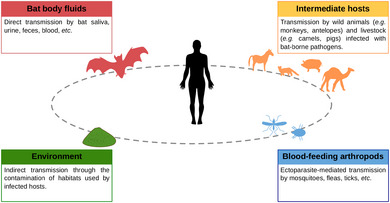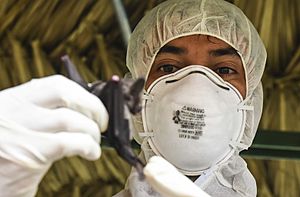Bat virome facts for kids
The bat virome is the collection of all the different viruses that live in and on bats. Bats are amazing animals that host a huge variety of viruses. Scientists have found all seven main types of viruses in bats. Many of the viruses found in bats belong to a group called Coronaviridae.
Bats carry several viruses that can also infect humans. These are called zoonotic viruses. Some of these bat viruses are important "emerging viruses," meaning they are new or newly spreading. Famous examples include the rabies virus, SARS-CoV, MERS-CoV, Marburg virus, Nipah virus, and Hendra virus. Scientists believe that SARS-CoV-2, the virus that causes COVID-19, originally came from bats. However, we don't know exactly how it spread to humans, or if another animal helped pass it along.
Even though bats carry many viruses, they rarely get sick from them. In fact, rabies is almost the only viral disease known to kill bats. Scientists study bats' immune systems to understand why they are so good at fighting off viruses. Bats' immune systems are different from other mammals. They have special ways to control their body's response to infections, which helps them avoid getting too sick. This means bats can often carry viruses without showing any signs of illness.
Contents
Many Different Viruses
| Virus family | No. sequences (n = 10,845) |
|---|---|
| Coronaviridae |
3,796(35.0%)
|
| Rhabdoviridae |
2,890(26.6%)
|
| Paramyxoviridae |
1,025(9.5%)
|
| Astroviridae |
724(6.7%)
|
| Adenoviridae |
365(3.4%)
|
| Polyomaviridae |
302(2.8%)
|
| Reoviridae |
288(2.7%)
|
| Circoviridae |
250(2.3%)
|
| Herpesviridae |
233(2.1%)
|
| Flaviviridae |
218(2.0%)
|
| Picornaviridae |
181(1.7%)
|
| Parvoviridae |
165(1.5%)
|
| Filoviridae |
123(1.1%)
|
| Hepadnaviridae |
78(< 1.0%)
|
| Papillomaviridae |
59(< 1.0%)
|
| Hantaviridae |
59(<1.0%)
|
| Caliciviridae |
43(< 1.0%)
|
| Peribunyaviridae |
31(< 1.0%)
|
| Nairoviridae |
22(< 1.0%)
|
| Retroviridae |
18(< 1.0%)
|
| Orthomyxoviridae |
8(< 1.0%)
|
| Phenuiviridae |
8(< 1.0%)
|
| Poxviridae |
6(< 1.0%)
|
| Picobirnaviridae |
4(< 1.0%)
|
| Togaviridae |
3(< 1.0%)
|
| Genomoviridae |
2(< 1.0%)
|
| Bornaviridae |
2(< 1.0%)
|
| Anelloviridae |
1(< 1.0%)
|
Viruses have been found in bats all over the world. Bats carry many different types of viruses. Most of these are RNA viruses, but they also have DNA viruses. Bats are more tolerant of viruses than other land mammals. A single bat can carry several different viruses without getting sick.
Scientists think that bats' ability to fly might help them deal with viruses. Flying makes a bat's body temperature go up, like a fever. This "flight fever" might help them fight off real fevers when they get a viral infection. Bats' immune systems have also changed over time to help them live with many viruses. They have a special way of responding to viruses that helps them fight off threats without overreacting. This balanced response keeps them healthy.
Bats also lack some parts of the immune system that cause a lot of inflammation in other mammals. While inflammation helps fight viruses, too much can harm the body. For example, the SARS-CoV virus can kill humans by causing too much inflammation. Bats' immune systems may have evolved to be more tolerant of stress, like viral infections.
How Viruses Spread to Humans
Most bat viruses cannot infect humans. The bat viruses that can infect humans usually spread in four ways:
- Contact with bat fluids: This includes blood, saliva, urine, or poop (guano).
- Intermediate hosts: Another animal gets the virus from a bat and then passes it to humans.
- Environment: Viruses might survive in the environment for a short time.
- Biting insects: It's possible, but not very likely, that insects like mosquitoes could spread bat viruses.
Lyssaviruses, like the rabies virus, usually spread from bats to humans through bites. But most other bat viruses don't spread through biting. Contact with bat fluids like guano, urine, and saliva is a common way for viruses to spread from bats to humans. Other mammals, like pigs, can also help spread bat viruses to people. For example, pig farms have been a source of bat viruses in Malaysia and Australia.
It's possible, but not confirmed, that hunting, preparing, or eating bat meat can spread viruses. There is little proof that bat viruses stay in the environment for a long time.
Bats and Other Animals as Virus Hosts
Scientists study bat viruses a lot, maybe more than viruses in other animals. This might be because bats are known to carry some important viruses. However, studies have shown different results on whether bats carry more zoonotic viruses than other animal groups.
One study found that bats, rodents, and primates all carry more zoonotic viruses than other mammals. But there wasn't a big difference between bats, rodents, and primates. Another study found that more diverse groups of animals (groups with many different species) tend to have more different viruses. Bats are the second most diverse group of mammals.
Studying Bat Viruses
Scientists use different ways to find viruses in bats. They can test a bat's blood for antibodies, which show if the bat has been exposed to a virus. They can also use special tests like PCR to find and copy tiny pieces of viral material. Viruses have been found in bat blood, saliva, poop, and urine.
Some ways of studying bats don't harm them. Other ways require the bat to be killed. However, studies have shown that both methods find similar numbers of viruses. Sadly, some endangered bats have been killed for virus research.
DNA Viruses in Bats
Bats carry different types of DNA viruses.
Adenoviruses
Adenoviruses have been found in bat poop, urine, and from swabs taken from their mouths and bottoms. They are found in both large megabats and small microbats across many parts of the world.
Herpesviruses
Many different herpesviruses have been found in bats in North and South America, Asia, Africa, and Europe.
Papillomaviruses
Papillomaviruses were first found in bats in 2006. Since then, they have been found in several other bat species.
RNA Viruses in Bats
Most of the viruses found in bats are RNA viruses.
Reoviruses
Some reoviruses found in bats can cause illness in humans. For example, Melaka virus was linked to sickness in a family in Malaysia in 2006. The man said a bat had been in his home before he got sick. Another virus, Kampar virus, was found in another Malaysian man. These viruses are related to reoviruses found in bats. No reoviruses linked to bats have caused human deaths.
Many reoviruses found in bats do not cause human disease. One example is Nelson Bay orthoreovirus, which was first found in a gray-headed flying fox in Australia in 1970.
Astroviruses
Astroviruses are very common in bats. Studies in Hong Kong and China found that almost half of the bats tested carried astroviruses. None of the astroviruses found in bats are known to cause disease in humans.
Several coronaviruses that can infect humans are linked to bats. These include severe acute respiratory syndrome coronavirus (SARS-CoV), Middle East respiratory syndrome-related coronavirus (MERS-CoV), and SARS-CoV-2.
SARS-CoV, SARS-CoV-2, and MERS-CoV
SARS-CoV causes the disease severe acute respiratory syndrome (SARS). The first SARS case was in China in 2002. It became a worldwide outbreak, affecting many countries and causing deaths. Scientists found that bats were the natural source of SARS-CoV. It's unclear if other animals, like civets, helped spread the virus from bats to humans, or if humans got it directly from bats.
The first human case of Middle East respiratory syndrome (MERS) was in Saudi Arabia in 2012. MERS has caused many cases and deaths in different countries. It's believed that MERS-CoV came from bats, but camels are likely the animals that passed it to humans. The virus can spread from person to person, but not easily.
The SARS-CoV-2 outbreak started in China in 2019. Genetic studies show that SARS-CoV-2 is very similar to viruses found in horseshoe bats. This clearly suggests that bats are the natural source of SARS-CoV-2. We still don't know exactly how the virus spread to humans, but another animal might have been involved.
Bats carry a huge variety of other coronaviruses. Scientists have found hundreds of new coronavirus strains in bats just in China.
Flaviviruses
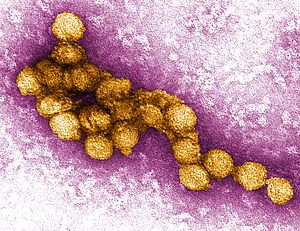
Most flaviviruses are spread by insects, but bats might play a role in some. Several types of Dengue virus have been found in bats. West Nile virus has also been found in fruit bats in India. Other flaviviruses found in bats include Saint Louis encephalitis virus and Japanese encephalitis virus.
Several types of picornaviruses have been found in bats around the world.
Negative-sense Single-stranded RNA Viruses
Filoviruses
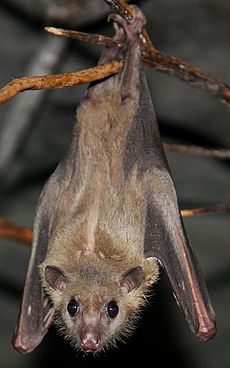
The Filoviridae family includes two important groups of viruses found in bats: Marburgvirus and Ebolavirus. These cause very serious diseases in humans, Marburg virus disease and Ebola virus disease. These diseases are rare but often deadly.
Ebola virus disease is a dangerous illness in humans, with a high death rate. The first outbreaks were in 1976. Scientists are still trying to find the natural source of ebolaviruses. Some evidence suggests that large fruit bats might be the source. However, it's hard to prove this because scientists haven't been able to find the actual ebolaviruses in fruit bats very often.
Marburg virus disease (MVD) was first found in 1967. It is also very deadly. The Egyptian fruit bat is now known to be the natural source of Marburg virus. Humans can get Marburg virus if they spend a long time in mines or caves where these bats live. The virus can also spread from person to person through contact with infected body fluids.
Rhabdoviruses
Rabies-causing Viruses
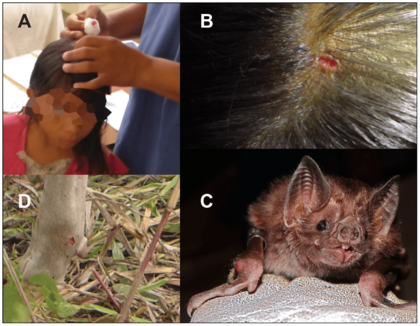
Lyssaviruses, including the rabies virus, are a group of viruses often carried by bats. Unlike most other viruses in this family, lyssaviruses are spread by mammals, usually through biting. All mammals can get lyssaviruses, but bats and carnivores are the most common natural sources. Most human rabies cases come from the rabies virus itself.
After a person is infected, they usually don't show symptoms for about two months, but it can be shorter or much longer.
Scientists first thought bats could spread rabies in the early 1900s. Vampire bats were the first bats found with rabies. Later, rabies was found in insect-eating bats too. Only a small number of healthy bats carry rabies. However, sick bats are more likely to have rabies. While rabies can be deadly for bats, many bats exposed to the virus don't get sick. In other mammals, rabies exposure almost always leads to death.
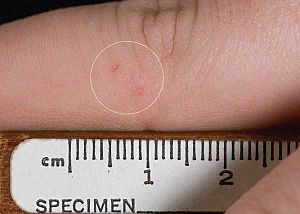
Around the world, dogs are the main source of human rabies deaths. But in North and South America, Western Europe, and Australia, bats are the most common source of rabies in humans. Many types of bats can spread rabies to humans, including those that eat insects, fruit, nectar, or blood. The common vampire bat spreads rabies in Central and South America.
Sometimes, people get rabies from bats without remembering a bite. Bat bites can be so small they are hard to see. Rabies can also spread if infected fluids touch a wet part of the body, like the eyes or mouth, or a break in the skin.
Other Rhabdoviruses
Many other bat lyssaviruses do not infect humans. These include Lagos bat lyssavirus and Shimoni bat lyssavirus.
Orthomyxoviruses
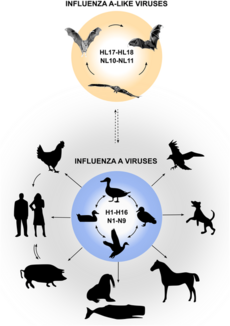
Orthomyxoviruses include influenza viruses. While birds are the main source of influenza A viruses, some bat species in Central and South America have also tested positive for them. This suggests that influenza A infections are common in bats in these areas.
Paramyxoviruses
Hendra, Nipah, and Menangle Viruses
The Paramyxoviridae family includes several viruses found in bats that can infect humans. Two important ones are Hendra virus and Nipah virus.
Hendra virus was first found in Australia in 1994. Different types of flying foxes carry this virus. Horses are the animals that spread Hendra virus from flying foxes to humans. There have been outbreaks of Hendra virus in horses, and some humans have been infected, with some deaths. It's not clear how horses get the virus, but it's thought to be from contact with flying fox fluids. A vaccine for horses was released in 2012.
The first human outbreak of Nipah virus was in Malaysia in 1998. Flying foxes were found to be the source, with domestic pigs acting as the intermediate hosts. Outbreaks have also happened in Bangladesh, India, and other countries. In Bangladesh, people often get Nipah virus from drinking date palm sap. Bats can contaminate the sap with their urine or by licking it.
Another virus that bats carry and can infect humans is Menangle virus. It was first found at a pig farm in Australia. Flying foxes were identified as the natural source, and two farm workers got sick with flu-like symptoms from the virus.
Images for kids
-
A scientist swabs the muzzle of a tricolored bat in a cave in Tennessee
See also
 In Spanish: Virus portados por murciélagos para niños
In Spanish: Virus portados por murciélagos para niños
- Histoplasmosis
- Human virome


